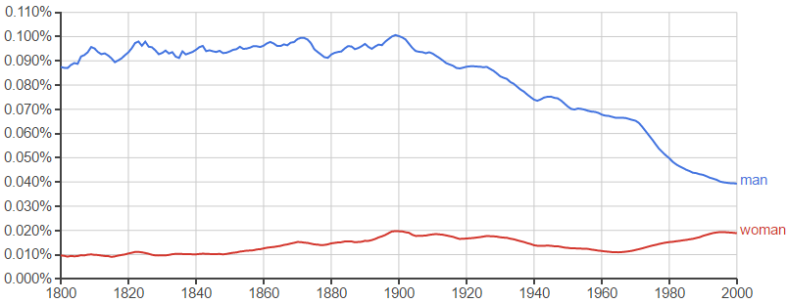The Canadian parliament recently changed the national anthem from “in all our sons command” to “in all of us command.” Gender neutral. Somehow I don’t think the Supreme Court will strike that one down; it seems to line up with their political views. I thought it might be interesting to see the trends in gender language over the past couple of centuries.
As always, here’s a link to the first post in this series for those who aren’t familiar with Google’s ngram viewer.
So this chart is interesting.
Starting around 1900 there was a relatively steady decline in use of the singular word “man.” What’s a little harder to notice is from about 1850 to 1900 use of the singular word “woman” roughly doubled. What’s equally interesting, though, is how “woman” then dropped back to 1800 levels around 1960 after which time it once again significantly rose.
So “woman” has seen something of a roller coaster ride since 1800, whereas “man” was pretty steady prior to 1900 and then declined fairly steadily after 1900.
I’ll have a few blogs in this short series to explore the subject and one thing that will become clear is that use of the word “man” as shorthand to describe all of humanity is the predominant explanation for the disparity between references of the sexes as seen in this chart.
More later.
As an aside, I don’t actually have a problem with changing our national anthem to say “in all of us command.” Even the original language assumed that women were included, so the change is almost certainly faithful to the original intent of the wording. That’s not a hill worth dying on.
On the flip side, though, I would argue that was hardly a hill worth conquering either. Our obsession with some misguided sense of “equality” is leading our elected officials to invest their precious time in matters that, frankly, aren’t really worth the effort. These days the Supreme Court and our elected officials seem to have discovered a goldmine of solutions that are desperately in need of a problem.

You must be logged in to post a comment.